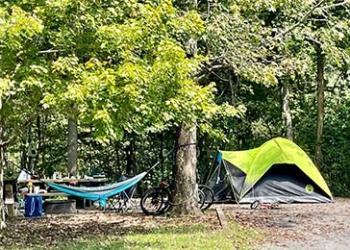Welcome to National Forests in Mississippi
From the pine forests of the Gulf Coastal Plain to the upland hardwoods in the northern part of the state, the National Forests in Mississippi covers 1.2 million acres of diverse natural resources and valued public lands spread across the state.
Recreation

The National Forests offers an abundance of outdoor recreation opportunities. Camping, hiking and fishing are just a few of the many attractions that draw more than one million visitors to the forest each year.
Maps

Be prepared with maps available in your preferred format: Interactive, downloadable and printable.
Passes

Many opportunities, services and facilities across the National Forests in Mississippi are free to enjoy. However, some activities do require fees or permits to help maintain, manage, and improve recreational amenities.
Forest Offices Contact Information
Address: 3473 Highway 35 South Forest, MS 39074
Phone: 601-469-3811
Hours: 7:30 a.m. - 4:30 p.m.
Address: 968 Highway 15 South Laurel, MS 39443
Phone: 601-428-0594
Hours: 7:30 a.m. - 4 p.m.
Address: 68 Frontage Road Rolling Fork, MS 39159
Phone: 662-873-6256
Hours: 8 a.m. - 4 p.m.
Address: 654 West Frontage Road Wiggins, MS 39577
Phone: 601-528-6160
Hours: Office Hours: 7:30 a.m. - 4 p.m.
Address: 1000 Front Street Oxford, MS 38655
Phone: 662-236-6550
Hours: 7:30 a.m. - 4 p.m.
Address: 1200 Highway 184 East Meadville, MS 39653
Phone: 601-384-5876
Hours: 7:30 a.m. - 4:00 p.m.
Address: 6052 Highway 15 Ackerman, MS 39735
Phone: 662-285-3264
Hours: 7:30 a.m. - 4:30 p.m. (M-Th) 7:30 a.m. - 4 p.m. (F)
Address: 6425 Lakeover Road, Suite A, Jackson, MS 39213
Phone: 601-965-1600
Hours: Office hours: 8 a.m. - noon and 1 p.m. - 4 p.m.
Program Areas
Administrative ------- 601 965-1649
Engineer -------------- 601-965-1603
Executive ------------- 601-965-1602
Fire -------------------- 601-420-6005
Heritage --------------- 601-965-1648
Lands ------------------ 601-965-1638
Natural Resources --- 601-965-1611
Planning --------------- 662-763-8374
Public Affairs --------- 601-965-1647
Recreation ------------- 601-408-0182
Ranger Districts
Bienville --------------- 601-469-3811
Chickasawhay -------- 601-428-0594
Delta ------------------- 662-873-6256
De Soto ---------------- 601-528-6160
Holly Springs --------- 662-236-6741
Homochitto ----------- 601-384-5876
Tombigbee ------------ 662-285-3264



